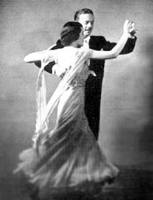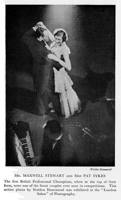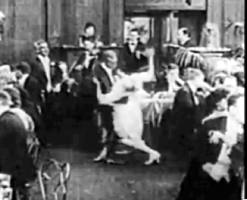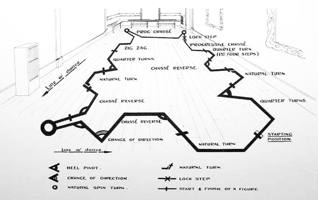
|
The Society of Folk Dance Historians (SFDH)
Evolution of English Ballroom Dance Style
[
Home |
About |
Encyclopedia | CLICK AN IMAGE TO ENLARGE |

|
In England, partnered dancing is done in a wide variety of styles, both informal and formal, but the most visible and promoted form is what the English call "International Style" ballroom dance, which is based on competition ballroom (DanceSport) technique and styling. This page is a brief look at how and why this style evolved.
EARLY COMPETITION STYLE
Small clubs in London began to hold competitions of a single dance form, like foxtrot or tango, in the early 1920s. Then the first English ballroom dance competition in combined forms premiered in March 1922.1
Early English competition ballroom style was easygoing, natural and understated. "All movement is easy, unaffected, which can be so easily ruined by exaggeration. The best dancers are the quietest; they do not flourish their prowess."2
Here is an "action photo" (that is, not posed) of the first British professional ballroom Champions, Maxwell Stewart and Pat Sykes. Note the relaxed frame, without any exaggeration or stiffness.3
SOCIAL DANCE FOCUS
Although the various ballroom dance Associations held competitions, their primary focus remained on the informal social dancers during the 1920s. In 1929, all of the Associations gathered for the first time, in the Great Conference, to gain consensus on what ballroom dance in England should be, both in steps and attitude. Philip J. S. Richardson was the Chairman of the Great Conference. Here is his report:
The discussion covered a very wide range of subjects, but by far the most important was the decision that the first aim of the profession should be to cater for the general dancer and not the expert. For this reason the basic steps of the standard dances and of any new dance should be kept as simple as possible.4
The Great Conference also decided to standardize ballroom dance music and tempos.
1930S SHIFT OF EMLPHASIS TO PROFESSIONALS AND COMPETITORS
In the next decade Richardson reported that, "the leading teachers were inclined to be a little too 'finicky'. Mountains were made out of molehills and trivial departures from what they taught regarded as heinous offenses."5 The gulf between social and competition dancers began to widen.
By the end of the 1930s, the ballroom dance Associations had shifted their focus from the social dancers to the professionals and competitors. For example, one of General Resolutions was that "dance hall managers should not allow any partner to give a lesson unless that partner were a qualified teacher," taking a "ballroom examination of one of the Teachers' Associations."6 This was referring to the informal dance halls of London, not just the competitions. A social dancer was not allowed to show his or her partner new steps unless he or she was a qualified teacher. Or rather, that was the wish of the ballroom dance Associations. The dancers themselves did not heed this request, and dance hall managers didn't enforce it.
BODY SWAY ENTERS THE ENGLISH WALTZ
In the 19th century, European ballroom dances either had a vertical body carriage, as in the waltz, or they leaned toward the direction of travel, as in the polka.
Counter-sway, where the body inclined against the direction of travel, with the hip leading the direction of travel, is widely acknowledged to be an African influence, and entered Western ballroom dancing through three different African populations.
1) African American counter-sway was first, appearing in some Ragtime Era dances at the turn of the century. This remained a hotly debated body motion in the U.S. for over a half-century, as evidenced by Dick Clark's ban of any hip movement on his 1950s American Bandstand show.
2) Afro-Brazilian counter-sway came next, as a prominent feature in the Brazilian Maxixe, which was introduced to Paris in 1905. The Maxixe was essentially Africanized polka. European immigrants had brought their polka to Brazil, where the population of former slaves modified it with their counter-sway. Here are Vernon and Irene Castle dancing the Maxixe in their 1915 film "The Whirl of Life." The counter-sway is clearly seen in the turning two-step.
French social dancers immediately adapted the Maxixe counter-sway into the way they danced the American One-Step, and still dance it with counter-sway to this day. But English and American ballroom dancers continued to execute the waltz and other ballroom dances vertically.
3) Next came Afro-Cuban counter-sway, in the Rumba, which became quite popular in the U.S. in 1931. In England the Rumba was observed from a distance, as "what they're dancing in New York," until a concerted effort was made to adopt the Rumba into English ballroom dancing in 1934. The August 1934 issue of Dancing Times magazine featured no less than six articles about Rumba, which mentioned the "side sway of the body."7 Another article stated, "In the Anglo-Saxon mind the idea of 'snaky hips' is inextricably bound up with the Rumba, and quite rightly, since in the palm groves of Camaguey it is the rolling lubricous hips which dance."8
Later that same month, the Rumba was finally adopted and standardized by the Official Board of Ballroom Dancing. The counter-sway in the official version was smooth: "These movements or figures are performed with a gentle sway of the hips."9 The standardized Rumba was described in the October 1934 issue of Dancing Times. The basic step of the Rumba was likened to the Waltz:
The basic steps are very similar in construction to those in the "square" formation movement sometimes used in teaching a Valse. The learner should practice the square Valse movement – forward with the left, to the side with the right, close the left to the right (one bar), back with the right, left to the side, close the right to the left (one bar). There are four counts to the bar in Rumba music, but only three in the Valse.10
In the same issue Victor Silvester reported that, "There has been no change in the Waltz in the past twelve months."11 That is, the waltz was still being dance vertically in 1934, without any sway.
That was soon to change. The Rumba became very popular in England in 1935, and since the Rumba step was similar to the Waltz, it was perhaps inevitable that Rumba counter-sway would be added to the English ballroom Waltz. The following year, the 1936 edition of Victor Silvester's Modern Ballroom Dancing, the definitive handbook for English ballroom dancing, featured this significant modification of the Waltz: "Body sway. Sway slightly to the L. on 2 and 3, and slightly to the R. on 5 and 6."12 (Consult the Rumba "square" above to correlate the steps that go with those counts.) The English preferred to think of this body sway as a Latin, rather than an African influence.
PELVIS CONTACT IS ADOPTED
A firm body contact at the pelvis also appeared in British competition-style waltzing during the 1930s. A battle had erupted among English competitors over the new "Staccato" style of tango, versus the old style, with the new style favoring quick snap-turns of the head (Richardson disapproved, "wondering which lady would get a crick in her neck first")13 and a firm body connection at the pelvis. As the dust of the debate settled, both ended up being adopted as the new English style of tango. Then just as the waltz borrowed body sway from the Rumba, English waltzing borrowed hip contact from the tango.
COMPLEXITY ENTERS THE ENGLISH WALTZ
Victor Silvester described his waltzing when he first became Champion in the 1920s: "I recall how simple our waltz was, just a natural and reverse turn and the forward and backward changes. No variations of any description." However by 1935, Richardson, Chairman of the Judges in most competitions, was complaining that, "Some couples at times appeared to me to introduce so many variations into their Waltz – and in many instances variations that belong to dances in another time – that the spirit of the Waltz was lost. The cause of this is obviously the feeling that if they do ordinary things they may not be noticed by the Judges."14 Teachers emphasized that waltzing must travel in Line of Dance, but the complex variations continued to win at the competitions, changing the English waltz into a series of complex steps, syncopations and changes of direction.
A MORE EXPANSIVE STYLE
In the 1920s the preferred English competition style was natural and understated, as quoted at the top of this page. Then ballroom competitors began to introduce broader and more exaggerated movements into their dancing during the 1930s. This happened in three stages, for three different reasons.
The first phase didn't come from the Associations, or from the judge's preferences. It came from audience reaction. One of the first examples was with the competition ballroom tango. To quote Richardson again, since he was one of the judges at that time, "Competitors found that these exaggerated movements, particularly a sudden turn of the head when changing direction [in the tango], earned the plaudits of the spectators, if not the marks of the judges. The quickstep was also passing through a phase of eccentricity largely caused by the desire of competitors to win approval from the crowd."15 These exaggerations were sometimes condemned by the judges at first, but the Associations became acclimated to the changes, and they eventually became the new style.
SECOND REASON FOR A MORE EXPANSIVE STYLE
In the January 1934 Dancing Times, E. Murray Bumstead commented on the space required to perform the standardized routines: "The real difficulty is that the dances which have been taught by the teachers during the last ten years, and have been brought to perfection mainly by competitions, require plenty of space and are therefore totally unsuitable for the smaller dance floors provided at the hotels, etc."16
Richardson agreed, in a following issue of the magazine: "Vast floors, such as that at Blackpool, seem to me to demand that the dancers should be very broad in their work, and to favor the tall couples who are at once conspicuous. The natty bantam pair with subtle movements and scrupulously accurate technique are apt to be overlooked on a floor space of twenty thousand square feet."17
The third phase occurred when competitions introduced the format of the elimination round, where the competition began with a fairly crowded floor, filled with all of the competitors dancing at once. The judges thinned the crowd down to a few finalists – those to be individually evaluated. This change in competition format resulted in a dramatic change in the look of competitive ballroom dance. The dancers had to perform far more expansive movements, to stand out from the crowd. Extreme, exaggerated movements and costuming were a matter of survival, either outshining the others or being quickly eliminated.
To this day, this extremely expansive style remains a distinctive difference between social and competitive ballroom dance.
PUTTING THIS STYLE IN PERSPECTIVE
This page describes the evolution of English competition-based "International Style" ballroom dance, for those who are wondering how and why it developed its unique look. However this style was only danced by a small percentage of the English, the majority of whom did informal social ballroom dancing.
This fact was reported in Dancing Times magazine throughout the 1920s and 30s, often referring to the informal social dancing majority as the "big public," which Richardson explained, "I mean not the comparatively few competition fans."18 That same year, 1934, Champion Alex Moore wrote, "Most people who learn to dance have no desire to become expert dancers. Therefore they are more likely to go to the teacher who can impress them with the simplicity of their methods than the one who makes the mistake of overburdening the pupil with their knowledge of technique."19
What percentage of English dancers learned competition ballroom dance style? Victor Silvester estimated 1%. In 1936 The Dancing Times reported that when it came to the popularity of social dancing in England, the waltz was seen as the best indicator because it had become the most popular dance on the floor. That same year Silvester estimated that after 14 years of competitions standardizing and perfecting the new English ballroom waltz, "ninety-nine people out of a hundred do the steps that have come to be known as the old-fashioned waltz,"20 meaning the non-competitive social style.
Moreover, Dancing Times complained that the English newspapers often reported on the informal social dance scene while mostly ignoring the competition ballroom events. "It has always been a matter of regret to the Dancing Times that the importance and the possibilities of the British Ballroom Championships are not more fully recognized by the daily press of the Metropolis. We cannot expect others to recognize the importance and possibilities of an occasion which is relegated to a very brief paragraph in the leading press of the country."21
But competition ballroom dancers made up in enthusiasm what they lacked in numbers, and International Style ballroom dance and DanceSport continue to be practiced by thousands of dancers to this day.
BIBLIOGRAPHY
1 Richardson, Philip J. S. (1945). A History of English Ballroom Dancing. London: Herbert Jenkins Ltd. 54.
2 Moore, Alex. "The Practical Side of Teaching." The Dancing Times, October 1935 issue. London: The Dancing Times. 36.
3 Richardson, Philip J. S. (1945). A History of English Ballroom Dancing. London: Herbert Jenkins Ltd. 48.
4 Richardson, Philip J. S. (1945). A History of English Ballroom Dancing. London: Herbert Jenkins Ltd. 75-76.
5 Richardson, Philip J. S. (1945). A History of English Ballroom Dancing. London: Herbert Jenkins Ltd. 92.
6 Richardson, Philip J. S. (1945). A History of English Ballroom Dancing. London: Herbert Jenkins Ltd. 80.
7 Young, R. Clemson. "The Rumba in Cuba." The Dancing Times, August 1934 issue. London: The Dancing Times. 480.
8 Rice, Cyril. "The Rumba in Spain." The Dancing Times, August 1934 issue. London: The Dancing Times. 482.
9 Sykes, Pat (1935). Season 1935, How To Dance. London, W. Foulsham & Co Ltd. 50.
10 Mackenzie, Alec. "The Rumba." The Dancing Times, October 1934 issue. London: The Dancing Times. 31.
11 Silvester, Victor. "The Season's Waltz." The Dancing Times, October 1934 issue. London: The Dancing Times. 35.
12 Silvester, Victor. (1936). Victor Silvester's Modern Ballroom Dancing, 1936 Edition. London: Herbert Jenkins, Ltd. 70.
13 Richardson, Philip J. S. "Ballroom Notes." The Dancing Times, March 1936 issue. London: The Dancing Times. 773.
14 Richardson, Philip J. S. "Ballroom Notes." The Dancing Times, August 1935 issue. London: The Dancing Times. 489.
15 Geographia. (1923). The Modern Ballroom Dance Instructor. London: Geographia, Ltd. 5.
16 Richardson, Philip J. S. (1945). A History of English Ballroom Dancing. London: Herbert Jenkins Ltd. 102.
17 Bumstead, E. Murray. "Tempo and the New Dances." The Dancing Times, January 1934 issue. London: The Dancing Times. 474.
18 Richardson, Philip J. S. "Ballroom Notes." The Dancing Times, April 1934 issue. London: The Dancing Times. 26.
19 Richardson, Philip J. S. "Ballroom Notes." The Dancing Times, August 1934 issue. London: The Dancing Times. 476.
20 Silvester, Victor. "The New Viennese Waltz." The Dancing Times, September 1936 issue. London: The Dancing Times. 600.
21 Richardson, Philip J. S. "The Championships." The Dancing Times, July 1935 issue. London: The Dancing Times. 354.
Used with permission of the author.
This page © 2018 by Ron Houston.
Please do not copy any part of this page without including this copyright notice.
Please do not copy small portions out of context.
Please do not copy large portions without permission from Ron Houston.



